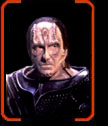 The Cardassians are arguably Star Trek's most dramatically engaging and
complex villains. A reptilian, warmongering race living under a brutal
and morally primitive regime, they were originally a peaceful people
that have gradually been corrupted by military rule.
The Cardassians are arguably Star Trek's most dramatically engaging and
complex villains. A reptilian, warmongering race living under a brutal
and morally primitive regime, they were originally a peaceful people
that have gradually been corrupted by military rule.
First introduced in the Next Generation fourth season episode The
Wounded, the depths of the Cardassians' barbarism was highlighted in the
following year's two-part story Chain of Command, where their leader Gul
Madred tortured Captain Picard into near-submission. However, recent
episodes of Deep Space Nine - where the Cardassians are typically the
showcase villains - have presented the race in less absolute terms. This
shift is frequently expressed in the ambivalent form of Gul Dukat,
played by Marc Alaimo.
The history of the Cardassian empire reveals an analogy of some of our
most infamous dictatorships. Their military authority has long believed
that ending the Cardassian people's starvation must come at the cost of
plundering and destroying other planets' resources and cultures. A
central focus of this rigidly executed policy has been Bajor, which the
Cardassians ruthlessly subjugated and exploited for 35 years.
The tension between the Bajorans and the Cardassians has been a central
theme of Deep Space Nine, where Captain Sisko has to balance his empathy
for the plight of the Bajorans with the need to maintain a peace treaty
between the Federation and the Cardassians - an invariably fraught task.
The Cardassians' military hierarchy is denoted by Senior Officers carrying the prefix 'Gul' (such as Gul Du Kat and Gul Madred) and
subordinates a less strapping 'Glin.'
Key Cardassian episodes: Ensign Ro, Chain of Command 1 and 2, The Chase,
(The Next Generation), Emissary, Return to Grace, Tribunal (Deep Space
Nine).
